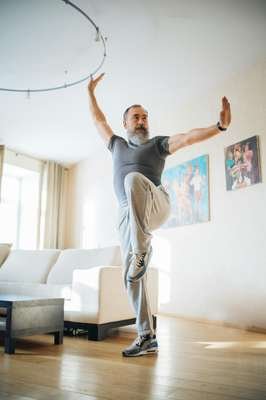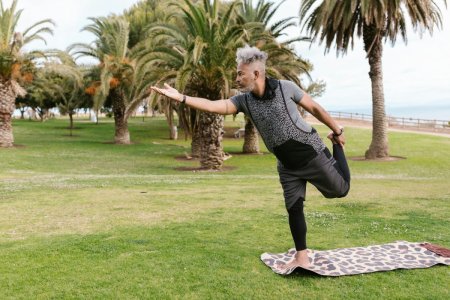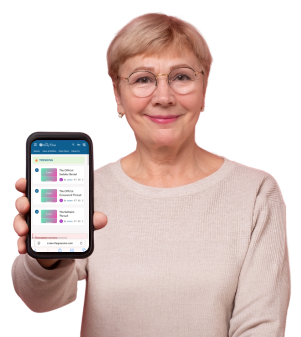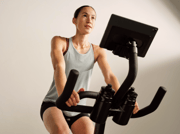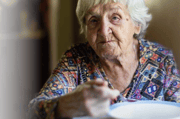Find out your real biological age with this simple balancing test—Are you aging too fast?
By
Aubrey Razon
- Replies 0
As we age, we often wonder, "How old am I really?" It’s not just about birthdays; it’s about health and vitality. What if you could discover your biological age with a simple balancing test?
In a world where the wellness industry often touts expensive tests like full-body MRIs and DNA analysis, championed by celebrities and biohackers alike, the Mayo Clinic's research offers a refreshingly simple alternative.
This test can be done at home or in a doctor's office without specialized equipment or expertise.
This test is not just a party trick; it's a window into the well-being of your bones, muscles, and nerves—the very pillars of your physical resilience.
Why does this matter?
Frailty, the decline in our body's strength and endurance, can leave us more susceptible to health complications, impede our recovery from illnesses, and increase the risk of falls.
It's a silent adversary that creeps up on us, often unnoticed until it's too late.
On average, a 50-year-old can maintain balance on one foot for about nine seconds.
By the time we reach 80, that number dwindles to a mere three seconds.
But it's not just about standing still; this balancing act engages a symphony of bodily functions:
He suggested that being able to balance on one leg for ten seconds with your eyes closed is a sign of good health, regardless of your chronological age.
They performed a series of tests to measure gait, balance, and strength, including grip strength and knee extension speed.
The most significant age-related decline was observed in the ability to balance on one leg. With each passing decade, participants' balance on their non-dominant leg decreased by an average of 2.2 seconds.
For the dominant leg, the decline was 1.7 seconds per decade.
First, take the test yourself. Stand on one leg and time how long you can maintain balance without support.
Remember to do this in a safe environment to prevent falls.
Compare your results to the averages mentioned above to get a sense of your biological age.
If you find your balance isn't what it should be, don't fret. This is a call to action, not a sentence.
Incorporating light weight training, yoga, or tai chi into your routine can help improve strength and bone mass.
Even simple daily practices like standing on one leg while brushing your teeth can make a difference.
The Mayo Clinic's findings are a testament to the power of simplicity in health assessment.
This balance test is a low-tech, high-value tool that can help you and your healthcare provider develop a personalized wellness plan.
Remember, understanding your biological age is more than just a number—it's about knowing your body and taking proactive steps to care for it.
So, go ahead, give it a try. You might just find that you're standing on solid ground.
 Have you tried the one-legged balancing test? Were you surprised by the results? Share your experiences and tips for maintaining balance and strength in the comments below.
Have you tried the one-legged balancing test? Were you surprised by the results? Share your experiences and tips for maintaining balance and strength in the comments below.
In a world where the wellness industry often touts expensive tests like full-body MRIs and DNA analysis, championed by celebrities and biohackers alike, the Mayo Clinic's research offers a refreshingly simple alternative.
This test can be done at home or in a doctor's office without specialized equipment or expertise.
This test is not just a party trick; it's a window into the well-being of your bones, muscles, and nerves—the very pillars of your physical resilience.
The Balancing Act of Aging
Researchers at the esteemed Mayo Clinic have uncovered a startlingly straightforward method to assess your biological age and overall health: the one-legged balancing test.Why does this matter?
Frailty, the decline in our body's strength and endurance, can leave us more susceptible to health complications, impede our recovery from illnesses, and increase the risk of falls.
It's a silent adversary that creeps up on us, often unnoticed until it's too late.
The One-Legged Test: A Measure of Time
The study's findings are as intriguing as they are practical.On average, a 50-year-old can maintain balance on one foot for about nine seconds.
By the time we reach 80, that number dwindles to a mere three seconds.
But it's not just about standing still; this balancing act engages a symphony of bodily functions:
- Tiny organs in your ears work overtime to maintain equilibrium.
- Your eyes provide visual cues to help orient you in space.
- Large muscle groups in your legs and trunk collaborate to keep you upright.
He suggested that being able to balance on one leg for ten seconds with your eyes closed is a sign of good health, regardless of your chronological age.
A Cost-Effective Health Indicator
The Mayo Clinic's study involved a diverse group of participants aged 50 to 80, excluding those with conditions that could skew the results.They performed a series of tests to measure gait, balance, and strength, including grip strength and knee extension speed.
The most significant age-related decline was observed in the ability to balance on one leg. With each passing decade, participants' balance on their non-dominant leg decreased by an average of 2.2 seconds.
For the dominant leg, the decline was 1.7 seconds per decade.
Implementing the Test in Your Life
So, how can you use this information?First, take the test yourself. Stand on one leg and time how long you can maintain balance without support.
Remember to do this in a safe environment to prevent falls.
Compare your results to the averages mentioned above to get a sense of your biological age.
If you find your balance isn't what it should be, don't fret. This is a call to action, not a sentence.
Incorporating light weight training, yoga, or tai chi into your routine can help improve strength and bone mass.
Even simple daily practices like standing on one leg while brushing your teeth can make a difference.
The Mayo Clinic's findings are a testament to the power of simplicity in health assessment.
This balance test is a low-tech, high-value tool that can help you and your healthcare provider develop a personalized wellness plan.
Remember, understanding your biological age is more than just a number—it's about knowing your body and taking proactive steps to care for it.
So, go ahead, give it a try. You might just find that you're standing on solid ground.
Key Takeaways
- The Mayo Clinic research suggests that balancing on one foot is an indicator of biological age, reflecting the condition of bones, muscles, and nerves.
- An average 50-year-old can balance for about nine seconds, while an 80-year-old manages around three seconds.
- Balancing requires the coordination of various bodily systems, including inner ear organs, visual cues, and muscle groups.
- Incorporating balance and strength exercises into daily routines could help improve neuromuscular health and potentially delay or avoid disability in the elderly.

